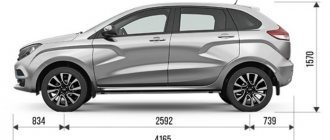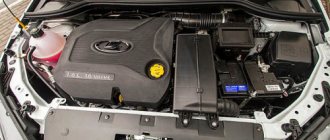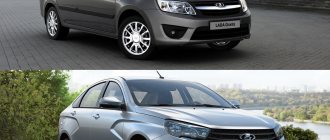On November 25, 2015, the opening of sales of the most long-awaited AvtoVAZ model of recent years, LADA Vesta, took place. If previously domestic cars competed only in the lower price niche, having several Korean and a number of Chinese cars as competitors, now the fight will begin in the so-called B+ segment, which includes the popular Kia Rio, Hyundai Solaris and Volkswagen Polo. In the AvtoVAZ line, Vesta replaced the Lada Priora, a deep restyling of the 1996 VAZ 2110. The basic Priora is now sold for 435 thousand rubles, and the price of Vesta in the initial configuration is 514 thousand, that is, significantly more expensive. What will a buyer get who decides to spend his hard-earned money on a more expensive, but modern car in the basic configuration?
Vesta's place among non-locals
For more than a year now, Vestas have been rolling off the assembly line and delighting happy car enthusiasts. During this time, the car showed itself at a high level. Previous Lada models are definitely inferior in many respects - within the Vesta brand there is no competition. But as for our foreign brothers, it makes sense to compete, which is what we will do today.
In this article we will separately compare such parameters as “appearance”, “dynamic characteristics”, “equipping options and prices”. The choice of competitors is quite large, but we will limit ourselves to five models that are most suitable for a fair and interesting fight:
- Volkswagen Polo Sedan
- Hyundai Solaris
- Renault Logan
- Skoda Rapid
- Kia Rio
All of the above cars are budget sedans with comparable technical characteristics and prices to the Lada Vesta. Each model has its own highlights and its own mistakes, which are more noticeable compared to other cars. But, since we are talking mainly about Lada Vesta, this new product of the domestic automobile industry will act as a background. So, let's start the review by examining the design of each car.
Nissan Almera - a budget car exclusively for Russia
Vesta was made almost exclusively for Russia, as well as for some CIS countries. In the same way, a few years ago Almera was made from the Japanese concern Nissan. The company developed a budget sedan in a fairly large size, equipped it with some proprietary appearance features similar to the then Teana generation, and also supplied the simplest and most durable technical components. As a result, Almera can surprise the buyer with the following features:
- excellent reliability inherent in a Japanese corporation, amazing capabilities of operation without special repairs and maintenance for a long time;
- very comfortable interior space, which largely follows the classic Japanese tradition of creating a high-quality passenger car interior;
- it must be admitted that Nissan Almera offers a more thoughtful, albeit simple, technology, which suppresses almost all the advantages of the new Lada;
- in terms of travel comfort, the Japanese is approximately on the same level as Vesta, but offers more efficiently used space inside;
- For its 499,000 rubles in the basic version, this car offers practically nothing active, but it is worth remembering that the car turned out to be cheaper than Vesta.
This is in the same class as the Russian Vesta, and the Japanese manage not to raise the cost of their equipment. It is also surprising that not many Russian buyers were favorable to this model. Today, the popularity of Almera is on the verge of profitability of sales, and even a frankly low competitive price does not help the company actively sell its offer.
Car appearance
As they say, people are greeted by their clothes, so let’s start with that. Agree, it’s quite a pleasant feeling when you leave your house in the morning and clearly see that your car has a special look among other unremarkable neighbors’ cars. Of course, everything here depends on your individual idea of modernity and uniqueness of design, so first of all, your personal opinion about the appearance of the car is important. Below we will transfer the analogy with neighbor's cars, only we will already know which of the neighbors drives what. So, let's break it down:
Crash test Lada Vesta - Leading auto portal
The safety of a car is determined by the so-called crash test. Leaders of the global automotive industry test cars in accordance with EuroNCAP requirements. The winners in their class, taking first place in the ranking, receive five stars.
High degree of vehicle safety. Excellent crash protection. Cars have accident prevention technology.
Good degree of emergency protection. Partially equipped with collision avoidance technologies.
Average security level.
Nominal degree of emergency protection.
Minimum (acceptable) level of vehicle safety.
The successes of the domestic automobile concern VAZ against the backdrop of victories of recognized foreign cars are much more modest - Lada Priora received two stars, and Lada Kalina (Universal) and Lada Granta - three.
Vesta in the “Lux” configuration has four passive airbags - two front and two side, built into the front seats. The vehicle's active protection is equipped with ABS and ESPBOSCH.
There are currently no official reports on the results of the Lada Vesta crash test. Factory tests were carried out in 2015 in the city of Dmitrov at the NAMI test site, but according to the policy of the AvtoVAZ concern, the results are not published.
There are two organizations that conduct independent crash tests in Russia: the magazines “Autoreview” and “Behind the Wheel”. In January 2016, Autoreview conducted a crash test for the Lada Vesta at the VAMI autodrome. You can find out how this happened by watching the video.
For comparison, the frontal impact test speed of the European standard is higher and is 64 km/h. There are other differences too.
The direct competitor of the Lada Vesta is the Volkswagen Polo, which is the safest in this class of cars today. The crash test results of a German car prove that the successful design of the car will reliably protect the driver and passengers in the event of a frontal collision or side impact, as well as in the event of a collision with a pole.
Time will tell whether the Lada Vesta will be able to compete with the VolkswagenPolo in terms of safety. “Autoreview” promises to publish the results of the Lada Vesta crash test in the third issue of the magazine. There's not long to wait.
Specifications. Dimensions
Technical characteristics are a rather loose concept. For the review, we chose the dimensional data of the cars and the dynamic capabilities of the engines, since this is what interests car owners most. So, let's start with the size of the cars, their ground clearance and trunk volume:
| Automobile | LxWxH | Clearance | Wheelbase | Trunk volume |
| Lada Vesta | 4410x1764x1497 | 178 | 2635 | 480 |
| Volkswagen Polo | 4390x1699x1467 | 163 | 2553 | 460 |
| Hyundai Solaris | 4405x1729x1469 | 160 | 2600 | 480 |
| Renault Logan | 4346x1733x1517 | 155 | 2634 | 510 Thanks for subscribing! |
| Skoda Rapid | 4483x1706x1461 | 170 | 2602 | 550 |
| Kia Rio | 4370x1700x1470 | 160 | 2570 | 500 |
And the Lada Vesta has the most impressive dimensions, losing only in height to its French competitor. The ground clearance is especially impressive - almost 18 centimeters versus 15-17 for other models. The wheelbase is also the largest, which gives the Lada a great advantage in the form of excellent stability. As for the volume of the luggage compartment, the Russian car firmly holds the middle position, and the Skoda Rapid wins everyone by a wide margin - the luggage compartment volume is 550 liters. Moreover, if the rear seats are folded down, the useful volume will increase to 1490 liters. As a result, it turns out that the most stable and passable car among those under consideration is the Lada Vesta, which is undoubtedly an advantage and puts it in first place in terms of dimensional characteristics.
Specifications. Dynamics
Now let’s find out which cars have the most powerful and large-capacity engines by studying the minimum and maximum configurations. The Lada Vesta is equipped with two engine options - a 1.6 liter with a power of 106 hp. and 1.8-liter with 122 hp. The first option comes as standard and, combined with a manual gearbox, accelerates the car to 100 km/h in 11.2 seconds. The second, more powerful engine has a phase adjustment mechanism, which helps very well in accelerating to 100 km/h, which is 10.2 seconds. The maximum speed with the 1.6 engine is 175 km/h, and with the 1.8 engine – 188 km/h. Let's compare other competitors with Lada.
| Automobile | Minimum equipment | Maximum configuration | ||||||
| Volume | Power | Overclocking | Max. soon | Volume | Power | Overclocking | Max. soon | |
| Lada Vesta | 1,6 | 106 | 11,2 | 175 | 1,8 | 122 | 10,2 | 188 |
| Volkswagen Polo | 1,6 | 90 | 11,2 | 178 | 1,4 | 125 | 9,0 | 198 |
| Hyundai Solaris | 1,4 | 100 | 12,2 | 185 | 1,6 | 123 | 10,3 | 193 |
| Renault Logan | 1,6 | 82 | 11,9 | 172 | 1,6 | 113 | 10,7 | 177 |
| Skoda Rapid | 1,6 | 90 | 11,4 | 185 | 1,4 | 125 | 9,0 | 208 |
| Kia Rio | 1,4 | 107 | 11,5 | 190 | 1,6 | 123 | 10,3 | 190 |
In its minimum configuration, Lada shares first place with Volkswagen in terms of acceleration to 100 km/h and beats only the Frenchman in terms of maximum speed. This puts Vesta in second place among the minimum configurations. In the maximum configuration – 4th position according to all the same parameters. Skoda is far ahead with its 9 seconds and 208 kilometers per hour, and Polo is close behind it, since it is equipped with the same technologically advanced 1.4 engines. But the maximum configuration is not an indicator, since prices can vary greatly, so we unanimously assign Vesta second place in terms of dynamic characteristics.
Ravon Gentra - if looks don't matter
In last place we will put a competitor who cannot but be remembered in this context. The Uzbek brand Ravon offers the Gentra car at a very low price - this is the lowest in its class. With all this, Rayvon Gentra belongs to the pure C-class and is one of the most optimal acquisitions for lovers of deep-rooted classics. Among the important features, the following features of the machine should be noted:
- quite presentable appearance, but obviously outdated design that cannot compete with modern developments, the same Lada Vesta;
- classic technical lines of the car, which adds advantages to the purchase; the Uzbeks did not update the technical part of the car, allowing buyers to obtain reliability;
- good equipment, albeit without the most amazing features, but with a very comfortable ride, taking into account all the features of the car’s origin;
- a spacious interior, well organized, because the predecessor of the car was the Chevy Lacetti, which has proven itself in our world for its practicality;
- the cost of only 439,000 rubles in the basic version is a real gift for lovers of the invincible classics, but the quality corresponds to the price threshold.
When buying a Ravon Gentra car, remember its origin. Most likely, you will find the optimal features of the transport for yourself only if you find the most suitable package for your case. Otherwise, you will initially not be too happy with the purchase and will find a lot of not very interesting features in the machine, which turned out to be the cheapest representative of our review today. We invite you to watch a comparison of Vesta with its main competitors in the video:
Options and prices
So we have crept up to the most interesting thing, because the price should determine the feasibility of all the above-mentioned delights. So, let’s arrange all the models in ascending order by price (basic configuration):
- Renault Logan is the cheapest among all and its cost is 479,000 rubles, which justifies all the shortcomings of this car brand.
- The official Lada website states the minimum price for the Lada Vesta is 515,900 , which immediately sets it apart from its competitors.
- Hyundai Solaris, Skoda Rapid, and Volkswagen Pol o share third place with each other, having a price tag of 599,000 rubles.
- And the Kia Rio with a price of 639,900 rubles loses to everyone in price.
Summing up, we can safely say that the domestic novelty took the top place of the honorary podium of the winners of this review, because for the cost of just over half a million, you get an excellent car with a good engine and an unusual bright design. We can be proud of this, because the domestic manufacturer has finally reached such a level that it has surpassed its European and eastern competitors in many respects. Of course, we are still far from absolute victory, but we are on the right path!
Hyundai Solaris - a little smaller, but in the same class
Of course, we can already hear the indignation of fans of the domestic automobile industry, because comparing Vesta and Solaris is somehow not very convenient. The car from the Korean brand is only slightly smaller than the Russian design, but it offers a lot of wonderful advantages that domestic transport can only dream of. Solaris turned out to be one of the most interesting proposals for Russians and this happened for many reasons:
- the car has perfectly updated its appearance and became completely modern only a few months ago, the car fits perfectly into the general flow on the road;
- technically the car is almost perfect, two engines and perfectly modified gearboxes are combined in the engine compartment and are well suited for Russia;
- the power of the power units is greater than that of the Russian, and in the cabin you can see better assembly, softer plastic and thoughtful interior space;
- driving a Hyundai is a little more comfortable; thoughtful and fully modified controls, braking and other functions improve the quality of the trip;
- at a cost of 569,000 rubles for the basic version, the car can easily compete with the more upscale Vesta with all its shortcomings.
It is clear that the Korean company has been developing the Hyundai Solaris for many years, starting with the very first Accent of 1998. The Russian company started everything from scratch and simply could not create the ideal car, despite cooperation with Nissan and Renault. Therefore, we may well turn a blind eye to some shortcomings, but in a comparative selection of cars, many will prefer Solaris.
What are the advantages?
“As I already said, Vesta is the best thing the plant has done, and, despite the nuances, there are many more advantages in it,” says the owner. — As befits Lada, low maintenance costs. Excellent appearance, nice interior, impeccable ergonomics. By the way, the width of the Vesta cabin is noticeably wider than that of its competitors - perhaps the widest in its class. Let’s not forget about good driving performance: Vesta behaves excellently on the highway and at the same time drives on rough roads like a good crossover. We also add high ground clearance as an advantage: not everyone can boast of this. It is impossible not to note the rich configurations: ABS, ESP, etc. Well, specifically about the station wagon, we can say that the trunk is not only very roomy, it is also well organized - in fact, no additional organizers are needed.
Specifically, my Vesta received a large package of improvements: the optics were replaced, the seats, interior, inserts were altered, a new Teyes multimedia system was installed with a reverse video camera, distance and lane control, and even tire pressure sensors. Many in the club also have aerodynamic body kits from Yurol, but I like the Vesta in appearance anyway.”
Removing the front door trim of Lada Vesta
The front cards are the most difficult to remove. They are attached to a larger number of fasteners, and there are more regulators. It is necessary to take into account the adjustment of the mirrors so as not to uproot any electrical wiring clips
Also, care should be taken when dismantling the power window unit - it is this unit that is most often damaged by inept actions with a screwdriver. Caution and lack of haste will be the key to getting the job done right.
The order of actions is as follows:
- Using a plastic spatula prepared in advance, unclip the plastic triangle lock in the area of the rear view mirror control unit. Just pry this element off at the top.
- Disconnect the electrical control connector to prevent it from being torn off when removing the card.
- At the bottom of the card, use the same spatula to remove the lampshade. Disconnect it from the connector and set it aside. Also unscrew the three card fastening screws located at the bottom of this element in the area of the lampshade.
- At the top of the end part (in the plane where the door lock is installed), carefully remove the round plug. Underneath there is another fastening screw that needs to be unscrewed.
- Inside the door closing handle there is another screw for securing the card, which also needs to be carefully unscrewed with a Phillips screwdriver.
- Next is the most difficult part - using a plastic spatula, carefully pry off the window regulator unit so as not to damage its delicate body. Remove the unit from its installation location and disconnect it from the connector.
- There is another fastening screw under the power window control unit that needs to be unscrewed.
- At the bottom of the casing, place a plastic spatula in any corner of the card and gradually pull the plastic towards itself. The clips will begin to come out of their installation locations, and the card will gradually be dismantled.
Once all the clips are removed, you will be able to completely remove the card and get to the metal part of the door. This is a simple procedure that you can do yourself without experience.
But you should pay special attention to accuracy when working with the power window unit. It is at this stage that most inept performers incur additional costs for themselves.
The case cannot be pryed off with a screwdriver, as it will be damaged and will look very ugly.











